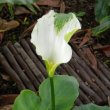| Botanical Name |
Zantedeschia aethiopica hybrid - Green Goddess |
| Family |
Araceae - The arum family. |
| Pronunciation |
zan-te-DES-kee-uh ee-thee-OH-pik-uh |
| Common Name(s) |
English: Arum Lily hybrid - Green Goddess
|
| Plant Group |
- Bulb / Corm / Rhizome / Tuber / Epigeal bulb Bulbs: are made up of fleshy scales as in an onion
Corm: a short, swollen, underground stem that is hard and not fleshy as in a gladiolus
Tuber: a solid, fleshy, underground, storage organ as in a potato
Rhizome: an underground, horizontal, swollen stem at the base of the plant as in an iris
Epigeal bulb: bulbs that rest above the ground with only the roots anchoring the plant to the earth as in albuca
|
| Plant Size |
- Medium to Large
| Tree | 15m to 20m |
| Shrub | 2m to 3m |
| Perennial/ground cover | 60cm to 75cm |
| Bulb | 60cm to 1m |
| Succulent | 60cm to 1m |
|
| Position |
- Canopy Shade Canopy shade is found below closely grown trees where some light filters through. Ideal for the protection of herbaceous plants.
- Deep / Full Shade Shade below spreading evergreen trees where sun's rays are unable to penetrate the canopy at any time. For light sensitive plants
- Light or Dappled Shade Found below trees with sparse, open foliage. Ideal for the protection of herbaceous plants.
- Partial Shade The area is in shade for part of the day and in full sun for part of the day.
|
| General Information |
- Deciduous to Semi-deciduous In warmer areas a deciduous plant may not lose its leaves during winter at all, or may lose its leaves for a very brief period, or may only lose part of its foliage.
- Drought Tolerance: Moderate The plant is moderately adapted to arid conditions and can survive short periods of drought and high temperatures without extra water.
- Evergreen Plants that have leaves all year round.
- Frost: Half-hardy The plant is able to survive low temperatures and some frost but requires protection against severe frost.
- Sand tolerant Plants adapted to survive in nutrient poor, very sandy soils.
- Water Loving Plants need a regular supply of water and must not be allowed to dry out for any length of time.
|
| Specific Information |
This hybrid of Zantedeschia aethiopica grows best with plentiful water and is a greedy feeder. It grows luxuriously in deep shade but flowering may be affected. Evergreen or deciduous depending on climate: dormant in summer in the Western Cape, and dormant in winter in other areas. It will remain evergreen if growing in conditions which are wet all year.
|
| Ad Break |
|
| Flowers |
| Description |
large green and white spathe with tiny yellow flowers on a central column
|
| Season |
- Spring to Summer Plants will seldom bloom for the entire season as given in the list, but should flower during a period within these parameters.
|
| Colour |
|
| Growth Rate |
- Moderate to Fast Specifying growth rate can be very misleading as there is considerable variation of growth rate depending on type and species of plant, available water, supplementary feeding, mulching and general care, as well as the plants suitability and adaptability to the garden environment.
|
| Plant Uses |
- Accent or Focal Point A plant used to attract the attention because of its colour or form.
- Attracts bees, butterflies or other insects This plant attracts insects which can be food for birds or other creatures in your garden.
- Border A strip of ground, at the edge of a driveway or path in which ornamental plants or shrubs are planted.
- Container Trees, shrubs and ornamental species that can adapt to growing in a restricted environment.
- Cut Flowers Plants that provide flowers suitable for ornamental uses.
- Filler Either a fast growing tree or shrub used temporarily to fill in an area while the permanent plants grow to a desired size, or a plant used to fill gaps in borders or beds.
- Suitable for coastal gardens Plants adapted to dry, sandy soil, forceful wind, limited rainfall and intense sunlight.
- Water Features These plants may have dramatic, lush foliage or graceful form. They do not shed excessive leaves and do not have invasive root systems.
|
| Distribution and Habitat |
|
| Planting Suggestions |
Arums need very rich, moist but well-drained conditions. Choose a shady position where you have easy access to water, and prepare the soil by mixing in compost, well rotted manure and any other additions your soil needs. Division of the rootstock is best done when the plant is dormant, but this is not essential. Plant the sections about 5 cm deep. Water regularly and mulch to retain moisture.
|
| Medicinal Uses |
|
| Ad Break |
|







Discuss this plant
Share knowledge, ask a question or give an experience.